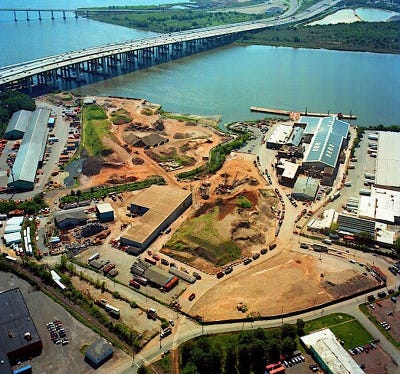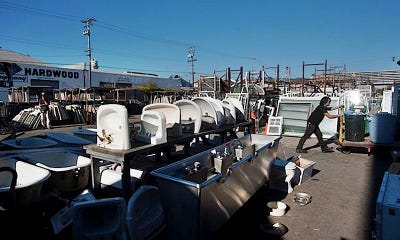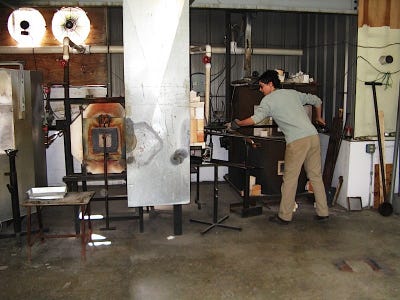Rational Parks
Eco-parks gather like-minded waste and environmental interests on brownfield sites to mine the benefits of collaboration.
April 19, 2013
Bruce Clark, P.E., Shani Kruljac and Marc Rogoff, Ph.D.
As environmental sustainability becomes more prevalent in all aspects of mainstream society, it is no surprise that communities and industrial developers are joining the “green” movement by promoting environmentally minded industrial parks. These “green” industrial parks — also known as eco-parks or resource recovery and energy parks — began making an appearance in the United States in the mid-1990s in different forms.
The basic idea is to create a space where multiple businesses can form a symbiotic relationship centered upon conservation of raw materials and other natural resources. Many eco-parks also strive to use alternative energy sources, as well as utilize recycled or earth-friendly materials in the designs and building construction. This article examines what eco-parks are, and what makes them desirable and successful.
 Although there is no formal definition of an eco-park, most observers identify a set of common characteristics, including:
Although there is no formal definition of an eco-park, most observers identify a set of common characteristics, including:
• An objective to have some portion of the waste stream recycled into another use.
• A new product for one industry, made using the waste of another.
• One or more businesses use an alternative and/or sustainable energy source.
• Potential to attract other economic development.
• A reduction of overall area-wide air emissions.
• Energy self-sufficient.
• Constructed using green building materials.
Some or all of these characteristics may apply to your project, as there is no specific prototype. Every community has different challenges and factors that go into creating a successful project.
Eco-parks can exist separately from other municipal waste functions, or within a waste complex. For example, the “Renewable Energy Park” developed by Pennsylvania’s Lancaster County Solid Waste Management Authority chose to focus on alternative energy, and thus their landfill-based complex includes a wind turbine and landfill gas-to-energy (LFGTE). They also wanted to embrace the historic elements of the region, so they maintain a historic building onsite.
Background
Kalundborg Denmark, founded in the 1960s, is widely recognized as the first industrial eco-park. Although it did not start out as a planned eco-park, it has been a model for symbiotic industrial development, where a cluster of companies rely on each other’s waste for material inputs.
The U.S. eco-parks being planned today had their origins in less modest projects that may not have had the total eco-complex look or function, but relied upon and helped promote eco-friendly technologies and sustainability ideals that are more commonplace today.
For example, in the late 1970s the City of Industry Calif., started planning a regional convention center and recreational resort on 600 acres of former municipal landfill. The result was a facility that utilized the landfill gas captured from the capped landfill as the energy source for the complex. The American Society of Civil Engineers selected the project as the Outstanding Civil Engineering Achievement in 1981.
The Urban Ore store, established in the early 1970s, was another early instance of what would become the eco-park philosophy. The salvage-and-sales operation in Berkeley, Calif., employs more than 30 people and salvages up to six tons per day of material that would normally be destined for the landfill.
The development of an eco-park may require many disciplines and talents that include economic and land use planners, attorneys, engineers, local business and community leaders, investors and financial institutions. Whether you need all of this expertise is a function of the complexity of the elements that will make your project. If your project has the potential to impact neighborhoods, it may be beneficial to include some local representatives in the planning process. Whether they support the project or not, obtaining their input early on can help you adjust plans accordingly and keep the project moving ahead.
Benefits
There are many potential benefits to a successful eco-park:
• Creation of new temporary (i.e., construction-related) and permanent jobs.
• New, long-term local economic growth and diversity of markets.
• Establishment of a new source of revenue for the community.
 • Reduction in the volume of waste disposed and in long-term costs related to landfilling.
• Reduction in the volume of waste disposed and in long-term costs related to landfilling.
• Production of materials with lower overall environmental impacts as compared to those produced from virgin resources (e.g., mulch or fertilizer).
• Use of materials that extract their maximumpossible value while reducing their environmental impact.
• Development of community pride.
• Beneficial reuse of underutilized land (i.e., brownfield sites).
• Preservation or restoration of environmental resources.
Moving Forward with Your Idea
How do you get started? First, there has to be a need for either the product produced or the services provided. The need for more employment opportunities, economic stimulation, the pursuit of beneficial use or re-use for a locally-produced good, and the desire to clean up and re-purpose a brownfield site are all viable reasons to pursue an eco-park.
Second, successful projects have shown the need for the project’s champion to lead planning efforts. A stakeholder group should be formed in order to assist with planning efforts throughout its development. This group should include like-minded people, but from diverse business, social and educational backgrounds. This diverse composition helps in several ways:
• Ensures a large, varied pool of ideas.
• Provides perspective from a technical, economic and fiscal standpoint.
• Spreads the workload so that the project can move forward more quickly.
• Establishes a network that helps in spreading the word to companies that would consider locating in the park.
Next, the development principles of the eco-park must be established. Examples of this might include requiring the park to function on self-generated energy, requiring onsite businesses to use waste from another industry or business in their manufacturing process, or limiting the overall carbon footprint of the park to some percentage less than that of a traditional industrial park.
Ideas are then put forth on what combination of activities or businesses might meet those principles while making economic sense for the region. Additionally, adequate land with proper zoning and basic utilities must be available or acquired. Availability of a low-cost energy source is very helpful.
Siting
Not surprisingly, the golden rule of real estate also applies to eco-parks: location, location, location. Keep in mind you are potentially competing with other developments for companies and institutions to locate in your park. So, the location, which is defined by amenities and features, is critical to success. Things to consider when choosing a site:
• Transportation network.
• Availability and cost of energy supplies, both in terms of fossil fuels and alternative sources.
• Compatibility of other businesses that already exist or are planned to be on site.
• Location relative to an appropriate workforce.
• Fees and other charges to businesses.
• Availability of suitable waste products for reuse in manufacturing.
 Some eco-parks or variations of a park are developed within the landfill complex themselves. This makes sense as the raw waste materials and byproducts are readily available, but also, these facilities typically have established buffers that facilitate handling of wastes without creating a new potential source of odors, and use established roads, thus avoiding new road construction.
Some eco-parks or variations of a park are developed within the landfill complex themselves. This makes sense as the raw waste materials and byproducts are readily available, but also, these facilities typically have established buffers that facilitate handling of wastes without creating a new potential source of odors, and use established roads, thus avoiding new road construction.
The Monterey Regional Waste Management District in Marin, Calif., has developed an eco-park within its waste disposal complex that includes LFGTE, a used merchandise buy-back store, and an anaerobic digester that provides compost to local farmers in addition to heating and powering the complex. They also constructed their scalehouse and offices out of recycled materials.
Some eco-parks take advantage of an ideal location through acquisition of former manufacturing facilities that often had prime locations near major roads and major waterways. For example, in Charlotte, N.C., a developer is moving forward with plans to re-develop a former 667-acre brownfield, previously a textile manufacturing complex, into ReVenture Park. The plans call for renewable power plants (including solar), alternative energy R&D, a green business incubator, renewable fuels production, recycling and regeneration of materials, related vocational training facilities, agriculture and composting.
Revenue Base Funding
Funding an eco-park is the most critical part of its development. How it is done depends on the community or business owner who has jurisdiction over the facility. Governmental grants are sometimes a good source of funding to assist in the required feasibility and marketing assessments. Unconventional sources of funding include sale of power generated from landfill gas and other waste-derived fuel sources.
For over two decades landfill methane has been an alternative energy source, and the primary element putting the “eco” in several eco-parks. Methane has been piped to eco-parks from landfills as far away as 10 miles. The production of electricity in standardized engine gen-sets is a reliable and proven technology that can produce power at a competitive price. The sale of the electricity can represent a significant annual revenue stream, and the sale of greenhouse gas credits (in the form of renewable energy certificates) for converting the methane represents another potential revenue source for the park’s owners.
Catawba County, N.C., funded the first phase of its Regional EcoComplex and Resource Recovery Facility, via a combination of revenue sources, including the sale of LFGTE-generated electricity to the power company, water and sewer funds, user fees, and investments from the project’s business and research partners. Gaston County, N.C., also has established its Green Energy Eco-Industrial Park featuring a LFGTE power plant to provide power and heat at a competitive price to industries in their planned eco-park.
Grants can fund planning and marketing studies, and sometimes the actual development of the eco-park. Creativity in project development is key here, but being familiar with the economic or environmental goals and priorities of your region will prove helpful in determining what types of grants are available. For example, if you target a lower-income enterprise zone or a designated brownfield area for the development of an eco-park, there may be local, state or federal agencies willing to give grants in return for furthering their development or environmental goals. The pursuit of grants is especially important in the planning and marketing stages, as it oftentimes requires action and investment from local government to jumpstart the eco-park’s development. Ideally, the community will then be able to attract private investors to carry the project beyond its initial stages.
Keep in mind that experimental technologies are constantly being developed and many companies working with them receive federal and state funding. Many of these companies are looking for research partners and platforms to conduct their research and development activities. Thus, partnerships with universities and colleges in the region can be valuable assets to an eco-park. Incorporating a research component can augment the entrepreneurial spirit of innovation, potential for national and international recognition, grant funding and other aspects that may be difficult to quantify, but are the life-blood for many eco-parks.
Once such as example is the proposed EcoPark Complex being developed at the Prince William County Sanitary Landfill in Virginia. Although the site already contains a LFGTE facility, the county wanted to expand its alternative energy sources and provide an education resource to the local colleges and schools in the area. They are pursuing a partnership with George Mason University and are exploring the creation of a business incubator onsite in order to attract green companies. The facility will be built to LEED standards and will try to utilize energy from landfill gas.
Partners
As demonstrated in the example above, universities have created some eco-parks, or a university has been a major partner of a municipal eco-park. Either way, a university partner can be advantageous. Many universities are already conducting waste or energy research and are natural partners for collaboration. Universities excel at obtaining grant funds for research. Municipal governments can leverage this expertise with a partnership designed to help both parties. The university wants to do the research and needs a partner, and the municipality can provide the raw materials and space for that research.
Even though a university does not typically manufacture a product, it still can be in an eco-park and be associated with and benefit from solid waste. Rutgers University in New Jersey is a good example. The school recently opened its 32,000-square-foot EcoComplex building on campus powered by electricity produced from landfill gas. They actually conduct research on solid waste as well as develop other environmental technologies.
Businesses in an eco-park also can turn to the university for research assistance to test the viability of new technologies, to gain access to laboratories, to co-opt research personnel and office space, and to collaborate on manufacturing technologies and joint projects that are in concert with the goals of the eco-park.
Adaptability
Since eco-parks can take decades to fully materialize, plans must be flexible, practical and incorporate alternatives. Economic downturns, such as the recession that began in 2007, can sink an eco-park. Case in point: An ambitious privately funded eco-park in Florida fell victim to that very recession.
There are dozens of U.S. eco-parks that never made it off the drawing board because their plans were too ambitious, seemingly trying to incorporate every possible green technology. An issue with green technologies is that few survive the economic ups and downs of the marketplace over the span of years. For green technologies the marketplace is now global, which means an uneven playing field and difficultly predicting which technologies will succeed and grow.
It is better to be realistic about the businesses that could become your “anchors.” They need not be flashy; just basic necessary services or products. For example, in their Cabazon Resource Recovery Park in Mecca, Calif., the Cabazon Band of Mission Indians started with a waste wood-fired power plant. The EcoComplex and Energy Campus privately developed by Bayshore Recycling Corp. in Keasbey, N.J., started as an outgrowth of their public works contracting business and now incorporates an array of businesses all linked to state-of-the-art C&D and scrap metals reclamation and soil thermal treatment.
 Additionally, waste streams can change or be reduced. Take for example, The Energy XChange in Burnsville, N.C. The eco-park was started in the early 1990s and utilized landfill gas as an energy source for a ceramic kiln and glass furnace used by artists-in-residence. Although the gas from their closed seven-acre landfill has lasted 21 years, the county partners knew that it would not last forever, and started looking at alternative energy sources several years prior to the time when the gas is projected to run out. They eventually settled on used wooden pallets as an alternative fuel source.
Additionally, waste streams can change or be reduced. Take for example, The Energy XChange in Burnsville, N.C. The eco-park was started in the early 1990s and utilized landfill gas as an energy source for a ceramic kiln and glass furnace used by artists-in-residence. Although the gas from their closed seven-acre landfill has lasted 21 years, the county partners knew that it would not last forever, and started looking at alternative energy sources several years prior to the time when the gas is projected to run out. They eventually settled on used wooden pallets as an alternative fuel source.
Federal financial incentives for sustainable energy technologies typically have a limited time frame, and renewal is never assured. Thus, a manufacturing facility that produces a product for this sector can see their market diminished when the incentive ends. Uncertainty of the markets can be a huge deterrent for any business considering locating in the eco-park. Thus, it is very important to incorporate partnerships into the governance structure of the eco-park. Determining how tenants benefit financially from the cost savings associated with the eco-park (such as reduced energy and water use costs, tax benefits, etc.) needs to be addressed during project development and ideally among the tenants themselves.
Some businesses are lured to other localities by financial incentives. Depending on the culture of the community to support such initiatives, using tax dollars as financial incentives to attract green businesses may be a viable strategy.
One way to build in flexibility is to consider incorporating businesses that can use other types of wastes; for example, municipal bio-solids, agricultural/farm wastes, forest product wastes and certain non-hazardous industrial wastes, like sludge from a paper mill.
Closing
Eco-parks are being planned and developed at an unprecedented rate. Communities across the United States have realized that they must take more proactive measures to continue to increase their business, cultural and social capital, and all the while adhering to the tenets of environmental sustainability. These values dovetail nicely with the real need for advancing waste reduction and reuse, harvesting green materials, and developing alternative energy sources, initiatives that many business and residents are looking for in their communities. Eco-parks are one tool to help strive for and accomplish these sustainability goals.
Bruce Clark, P.E., [email protected], Shani Kruljac, [email protected], and Marc Rogoff, Ph.D. [email protected] work for SCS Engineers in Tampa, Fla.
You May Also Like


.png?width=300&auto=webp&quality=80&disable=upscale)